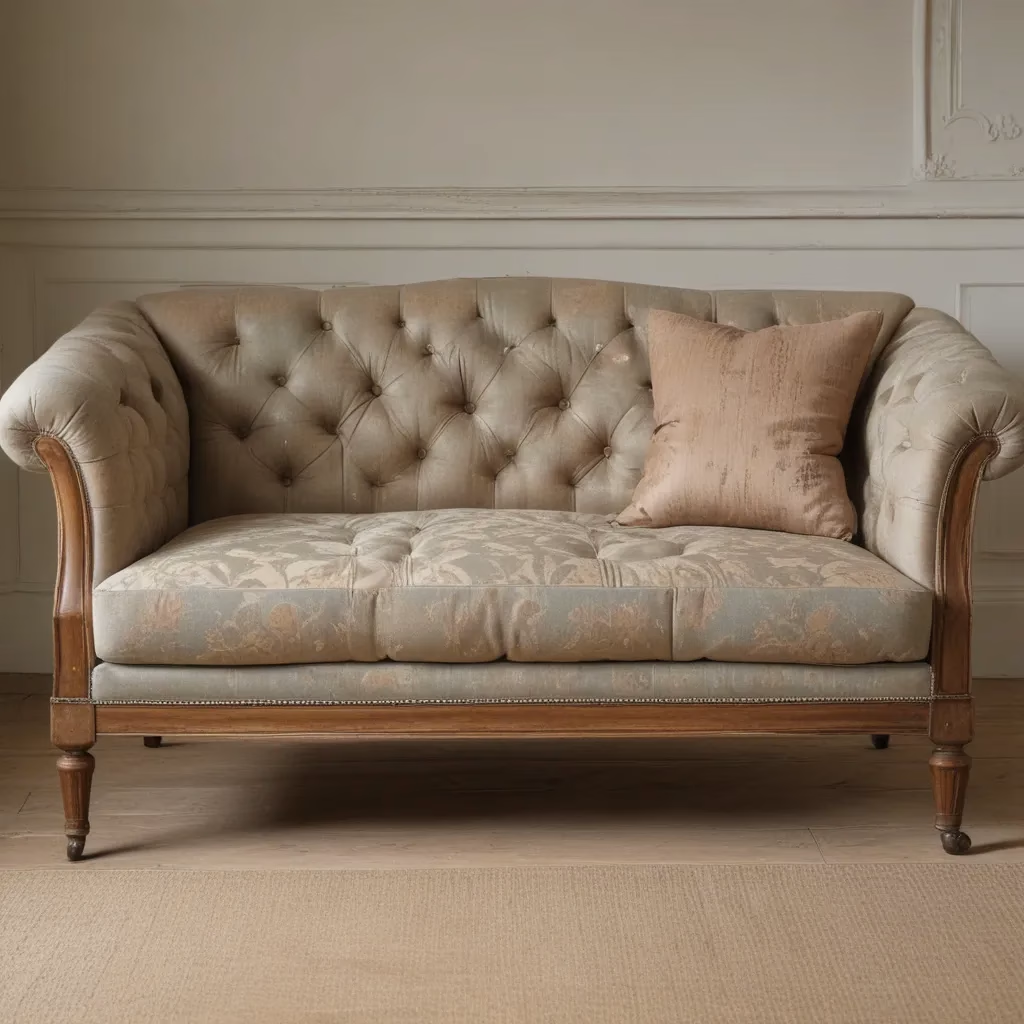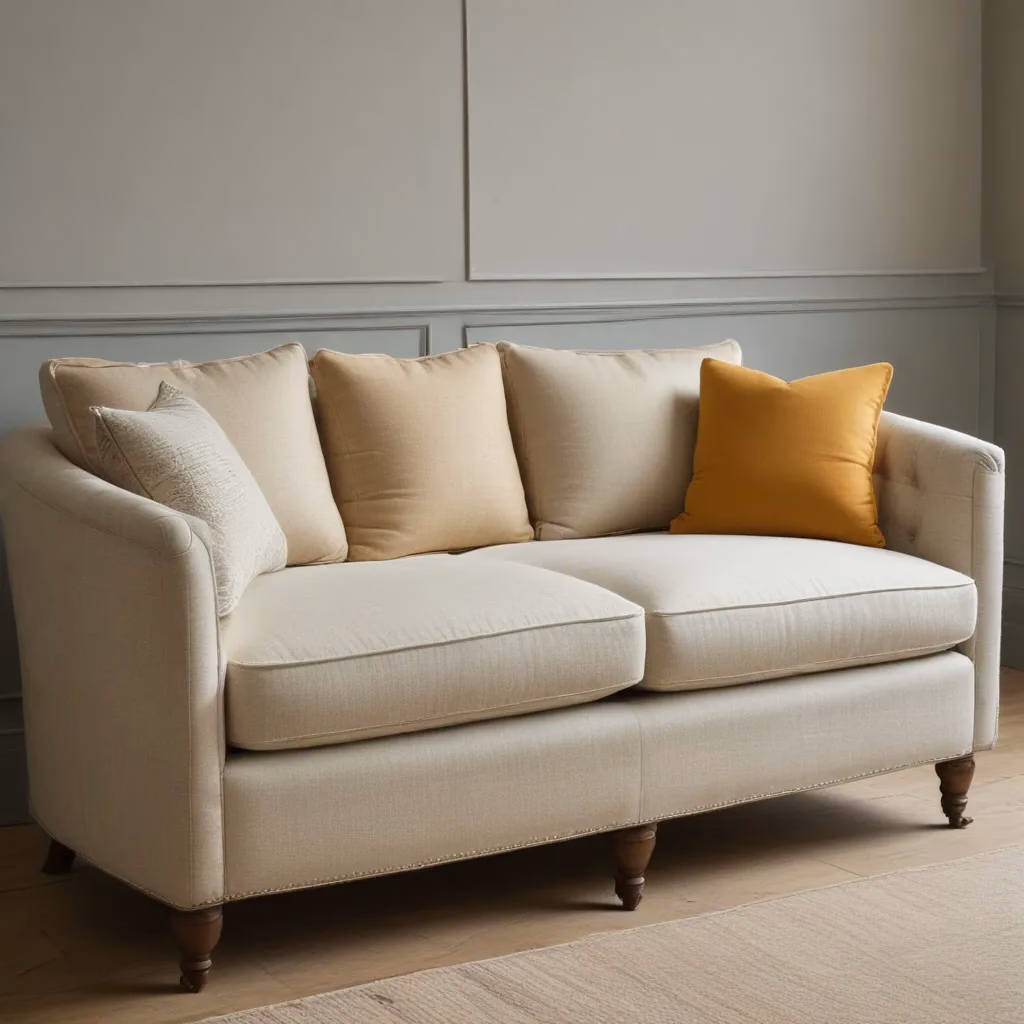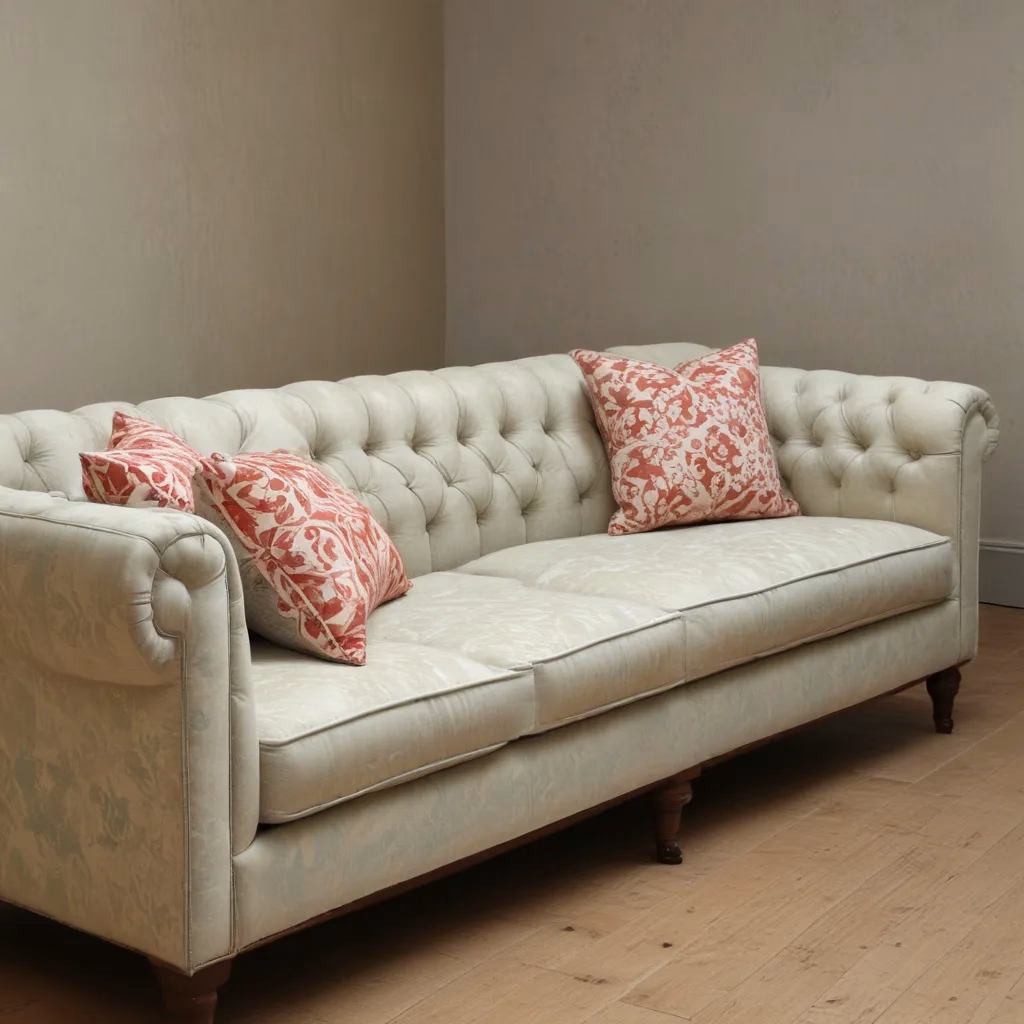
When it comes to breathing new life into a cherished piece of vintage furniture, the art of upholstery restoration can be truly transformative. As an experienced furniture consultant and interior design writer for SofaSpectacular.co.uk, I’ve had the pleasure of guiding countless clients through the process of reviving their old sofas with a fresh, stylish look.
In this comprehensive upholstery masterclass, we’ll explore the key considerations for selecting the perfect fabrics, mastering cleaning and maintenance techniques, and designing a cohesive living room layout that showcases your newly restored sofa. Whether you’re a seasoned DIY enthusiast or simply looking to breathe new life into a family heirloom, this guide will equip you with the knowledge and confidence to tackle your upholstery project with care and flair.
Fabric and Upholstery Selection
The foundation of any successful upholstery project lies in the careful selection of your fabrics. When it comes to vintage sofas, the allure of timeless patterns and rich, textured materials is undeniable. However, it’s important to strike a balance between aesthetic appeal and practical durability.
Vintage Fabric Trends
Embracing the charm of yesteryear, vintage-inspired fabrics can infuse your living space with a sense of history and character. From the elegant floral patterns of the 1920s to the bold, geometric motifs of the 1970s, there’s a wealth of inspiration to draw from. When selecting a fabric, consider how it will complement the existing décor and architectural features of your room.
Pro Tip: If you’re unsure where to start, peruse vintage design magazines or visit antique shops to get a feel for the styles and patterns that resonate with you. This can help you hone in on the perfect upholstery fabric for your sofa.
Upholstery Fabric Durability
While vintage-inspired fabrics can add undeniable charm, it’s crucial to double-check that they can withstand the wear and tear of everyday use. Look for high-quality, tightly woven materials that boast exceptional longevity, such as velvet, linen, or microfiber. These fabrics not only hold up better over time but also provide a luxurious, comfortable seating experience.
Did You Know? According to the experts at Nell Hills, “Performance fabrics” – those designed to be stain- and fade-resistant – have become increasingly popular in recent years, offering both style and practicality.
Fabric Care and Cleaning
Once you’ve selected the perfect upholstery fabric, it’s crucial to understand how to properly care for it. Regular vacuuming and spot cleaning can help maintain the fabric’s appearance, while deeper, professional cleanings should be scheduled periodically to keep it looking its best.
Tip: When it comes to cleaning vintage fabrics, always test a small, inconspicuous area first to double-check that the cleaning method doesn’t cause discoloration or damage. Gentle, pH-balanced solutions are often the safest bet.
Living Room Layout Tips
With your newly upholstered sofa as the focal point, it’s time to consider how it will fit into your living room’s overall design. Thoughtful furniture placement and accessory choices can transform a space, creating a harmonious and inviting atmosphere.
Arranging Furniture for Flow
The arrangement of your living room furniture can greatly impact the overall flow and functionality of the space. Position your sofa to encourage conversation and interaction, ensuring it’s not isolated or blocked by other pieces. Consider creating a cohesive seating arrangement by grouping complementary chairs, ottomans, or loveseats around the sofa.
Remember: Leave ample walkways and room for traffic patterns to move freely around the space.
Balancing Aesthetics and Functionality
While it’s important to create a visually appealing living room, don’t forget to prioritize comfort and practicality. double-check that your sofa is positioned to take advantage of natural lighting and provide a clear view of any entertainment systems or focal points. Incorporate end tables, ottomans, and other functional pieces to create a harmonious, well-balanced design.
Pro Tip: Experiment with different furniture configurations to find the layout that best suits your needs and personal style.
Lighting and Textiles
Thoughtful lighting and the strategic use of textiles can significantly enhance the ambiance and visual interest of your living room. Incorporate a mix of overhead, task, and accent lighting to create a warm, inviting atmosphere. Layer in textured throw pillows, cozy blankets, and area rugs to add depth and warmth to the space.
Hint: Rotating seasonal textiles, such as lighter fabrics for summer and heavier materials for winter, can help you easily refresh the look of your living room throughout the year.
Sofa Cleaning and Maintenance
Proper cleaning and maintenance are essential for preserving the longevity and appearance of your newly upholstered sofa. By following a few simple steps, you can keep your vintage furniture looking its best for years to come.
Spot Cleaning Techniques
Accidents happen, but don’t fret – with the right spot cleaning techniques, you can quickly and effectively address any spills or stains. Start by blotting the affected area with a clean, dry cloth to absorb as much of the spill as possible. Then, use a mild, pH-balanced cleaning solution and a soft-bristle brush to gently scrub the fabric, taking care not to rub too vigorously.
Caution: Always test any cleaning solutions in an inconspicuous area first to double-check that they don’t cause discoloration or damage.
Deep Cleaning and Conditioning
Periodic deep cleaning and conditioning can help maintain the integrity and appearance of your upholstered sofa. Depending on the fabric, you may want to enlist the services of a professional cleaner or explore DIY methods, such as using a steam cleaner or a specialized upholstery shampoo.
Pro Tip: Don’t forget to condition the fabric after cleaning to help preserve its softness and vibrant color.
Preventing Fabric Damage
To keep your vintage sofa looking its best, it’s essential to take proactive steps to prevent fabric damage. Rotate and flip the cushions regularly to double-check that even wear, and consider using furniture covers or throws when the sofa is not in use. Additionally, be mindful of direct sunlight, which can fade the fabric over time.
Remember: Proper care and maintenance will not only extend the life of your sofa but also help preserve its timeless beauty.
Styling for Comfort and Aesthetics
Transforming your living room into a stylish and comfortable oasis requires the perfect balance of form and function. By incorporating thoughtful design elements and paying close attention to ergonomics, you can create a space that is both visually stunning and exceptionally inviting.
Layering Textiles and Accessories
Elevate the aesthetic appeal of your vintage sofa by layering textiles and accessories. Mix and match throw pillows in a variety of patterns, textures, and colors to add depth and visual interest. Drape cozy blankets or a plush area rug to ground the space and enhance the overall sense of comfort.
Tip: When selecting accessories, consider how they will complement the existing color scheme and design elements in your living room.
Colour Palettes and Textures
The strategic use of color and texture can significantly impact the overall ambiance of your living room. Embrace the warm, inviting tones of your vintage sofa by pairing it with earthy hues, rich jewel tones, or soft, neutral shades. Incorporate a variety of textures, such as velvet, linen, or even natural wood, to create a visually engaging and tactilely pleasing space.
Pro Tip: Don’t be afraid to experiment with bold, contrasting colors or unexpected textile pairings to achieve a truly unique and personalized look.
Ergonomic Seating Considerations
While aesthetics are important, it’s equally crucial to prioritize comfort and ergonomics when styling your living room. double-check that your vintage sofa provides ample support and cushioning, perhaps by incorporating memory foam or high-density polyurethane foam into the upholstery. Consider the height, depth, and angle of the seat to double-check that it promotes proper spinal alignment and relaxation.
Remember: The true test of a successful living room design is how it makes you feel when you sink into your newly upholstered sofa.
Vintage Furniture Buying Guide
If you’re in the market for a vintage sofa to restore, there are a few key factors to consider to double-check that you make a wise investment.
Identifying Quality Construction
When evaluating a potential vintage sofa, look for signs of sturdy, well-crafted construction. Examine the frame for any signs of warping or damage, and test the springs and cushions for proper support and resilience. The attention to detail in the stitching and overall finishing touches can also provide clues about the quality of the piece.
Pro Tip: Don’t be afraid to consult an expert or experienced upholsterer for a professional assessment before making a purchase.
Assessing Restoration Needs
Understand that vintage furniture may require some level of restoration, whether it’s addressing worn-out upholstery, repairing structural issues, or refinishing the wood. Factor in the time, effort, and cost of these necessary improvements when negotiating a fair price.
Remember: Be prepared to invest in the restoration process to breathe new life into your vintage sofa and transform it into a cherished centerpiece for your living room.
Negotiating Fair Prices
When it comes to buying vintage furniture, negotiation is often part of the process. Research current market prices for similar pieces and condition, then use this information to make a fair offer that reflects the sofa’s value and your anticipated restoration costs.
Tip: Don’t be afraid to walk away if the seller is unwilling to meet your reasonable expectations. With patience and persistence, you’ll find the perfect vintage sofa at the right price.
Living Room Decor Trends
As you revive your vintage sofa, it’s essential to consider how it will integrate with the overall design aesthetic of your living room. From the timeless charm of modern farmhouse to the bold, maximalist allure of contemporary styles, there’s a wealth of inspiration to draw from.
Modern Farmhouse Aesthetics
The modern farmhouse trend marries the rustic appeal of vintage furnishings with clean, contemporary lines. Pair your restored sofa with natural wood accents, cozy textiles, and understated, neutral color palettes to create a warm, inviting space that celebrates the beauty of timeless design.
Pro Tip: Incorporate distressed or whitewashed finishes to amplify the vintage charm of your sofa and living room.
Bold and Maximalist Styles
For those seeking a more daring, eye-catching approach, the maximalist design aesthetic can breathe new life into your vintage sofa. Embrace bold, contrasting patterns, vibrant colors, and eclectic accessory pairings to create a living room that exudes personality and flair.
Remember: When experimenting with maximalist style, balance is key – avoid overwhelming the space by carefully curating your furniture and decor.
Minimalist Scandinavian Design
On the opposite end of the spectrum, the pared-back elegance of Scandinavian-inspired decor can provide the perfect canvas for your restored vintage sofa. Opt for a clean, uncluttered aesthetic that showcases the sofa’s craftsmanship and allows its timeless silhouette to take center stage.
Tip: Incorporate natural materials, such as linen or wood, to infuse your minimalist living room with a touch of warmth and character.
Upholstery Craftsmanship
The art of upholstery restoration is a true testament to the skill and expertise of dedicated artisans. Understanding the traditional techniques and the reupholstery process can help you appreciate the care and attention that goes into reviving a vintage sofa.
Traditional Techniques
Upholstery is a time-honored craft that has been passed down through generations. From the intricate tufting and button detailing to the precise application of trim and piping, each step in the upholstery process requires meticulous attention to detail and a deep understanding of the materials.
Did You Know? The experts at EZ2CY emphasize the importance of utilizing high-quality materials and employing exceptional craftsmanship when restoring vintage furniture or marine upholstery.
Reupholstery Process
Transforming a tired, worn-out sofa into a stunning, revitalized piece of furniture is no small feat. The reupholstery process typically involves carefully removing the existing fabric, assessing the condition of the underlying frame and cushions, and then meticulously applying the new upholstery material.
Pro Tip: Consider enlisting the help of a professional upholsterer, especially for more complex or intricate restoration projects, to double-check that the best possible outcome.
Customisation Options
One of the joys of reupholstering a vintage sofa is the opportunity to personalize it to suit your unique style and preferences. From selecting custom fabrics and trims to incorporating unique design elements, the possibilities are endless. Embrace your creativity and let your vision for the perfect living room take shape.
Remember: The true beauty of a restored vintage sofa lies in its ability to reflect your personal style and tell a story.
Furniture Care and Longevity
To double-check that your revived vintage sofa continues to grace your living room for years to come, it’s essential to implement a comprehensive care and maintenance routine.
Preventing Wear and Tear
Proactive steps, such as rotating and flipping the cushions regularly, can help mitigate uneven wear and tear. Additionally, using furniture covers or throws when the sofa is not in use can protect the fabric from sun damage, stains, and other environmental factors.
Tip: Encourage family members and guests to treat the sofa with care, avoiding activities that could cause unnecessary wear and tear.
Environmentally Friendly Supplies
When it comes to cleaning and maintaining your vintage sofa, strive to use eco-friendly, plant-based products that are gentle on both the fabric and the environment. Avoid harsh chemicals that could potentially damage the upholstery or release harmful fumes into your living space.
Remember: Investing in high-quality, sustainable cleaning supplies can help preserve the longevity and integrity of your vintage furniture.
Extending Furniture Lifespan
By following a diligent care and maintenance regimen, you can dramatically extend the lifespan of your beloved vintage sofa. Regular cleaning, professional upholstery services, and thoughtful usage habits will double-check that your restored furniture continues to be a cherished centerpiece in your living room for years to come.
Pro Tip: Embrace the patina and character that naturally develops on your vintage sofa – it’s a testament to its enduring quality and your commitment to preserving its timeless beauty.
As you embark on your upholstery restoration journey, remember that the process is as much about reviving a beloved piece of furniture as it is about cultivating a living space that reflects your unique style and personality. With the right care, attention to detail, and a touch of creativity, your vintage sofa will once again shine as the crown jewel of your living room.
Tip: Rotate cushions regularly to maintain even wear



